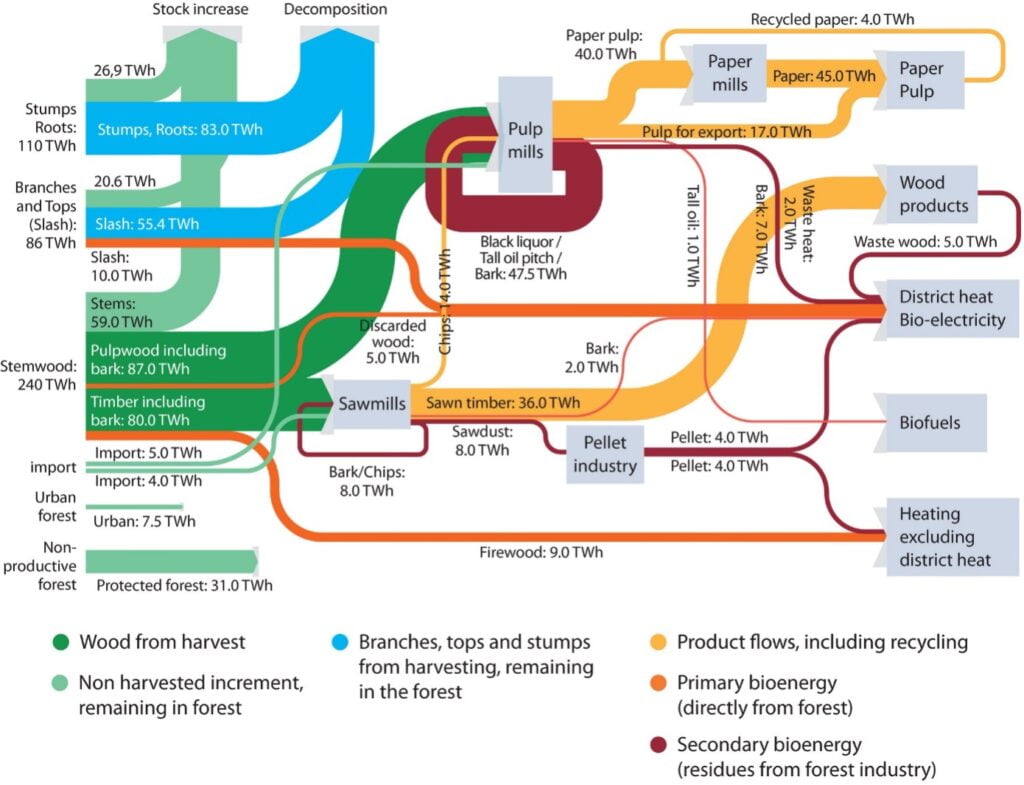From IEA Bioenergy, a sustainable solution
The scientific literature contains contrasting findings about the climate effects of forest bioenergy. A paper by IEA Bioenergy’s Task 45 identifies the misconceptions that can lead to conclusions that exaggerate or underestimate its effects.
This open-access article recently published in the Journal GCB Bioenergy is freely available at https://onlinelibrary.wiley.com/doi/epdf/10.1111/gcbb.12844. The paper is an output of IEA Bioenergy Task 45 ‘Climate and Sustainability Effects of Bioenergy within the broader Bioeconomy’. Twenty-eight scientists from around the world with expertise in forestry, climate and energy systems contributed to this article.
Summary:
The scientific literature contains contrasting findings about the climate effects of forest bioenergy, partly due to the wide diversity of bioenergy systems, but also due to differences in assessment methods.
The paper examines debated aspects related to climate impacts of forest bioenergy, in applications including heat production, electricity generation and transport. It identifies factors that are relevant to understanding the climate effects of forest bioenergy, and misconceptions that can lead to conclusions that exaggerate or underestimate the effects. The objective is to reduce confusion arising from publication of diverging studies on forest bioenergy, to inform policy development, business decisions and the public debate on bioenergy.
The temporal and spatial system boundary and the reference (counterfactual) scenarios are key methodology choices that strongly influence results of studies on the climate effects of forest bioenergy. Focussing on carbon balances of individual forest stands or comparing emissions at the point of combustion neglect system-level interactions that influence the climate effects of forest bioenergy. A systems approach (see Figure 1) should be used that:
- considers the whole life cycle of bioenergy systems, including effects of the associated forest management and harvesting on landscape carbon balances and the interaction with the production of wood products;
- identifies how forest bioenergy can best be deployed to support energy system transformation required to achieve climate goals; and
- incentivizes those forest bioenergy systems that augment the mitigation value of the forest sector as a whole.
There is a wide variation in published estimates of carbon payback time for forest bioenergy systems reflecting both inherent differences between these systems and different methodology choices. Critical methodology decisions include the definition of spatial and temporal system boundaries and reference (counterfactual) scenarios. Besides the subjectivity of payback time analysis, a focus on short term mitigation may rule out solutions with low, neutral or net negative emissions in the longer term which are needed to achieve the long-term temperature goal of the Paris Agreement. The issue of timing of mitigation benefits of forest bioenergy needs to be considered within a holistic assessment that includes land carbon dynamics and energy system transition, including the interaction with other forest products.
Greenhouse gas reporting under the UNFCCC does not assume that bioenergy is carbon neutral, as any reduction in forest carbon associated with harvest is counted [as a CO2 emission] in the Land use, land use change and forestry (LULUCF) sector. Nevertheless greater transparency and consistency is needed in greenhouse gas reporting and accounting related to bioenergy so that the connections between forest carbon stock change and use of biomass for energy are not overlooked.
Effective sustainability governance is required to ensure that forest biomass used for energy makes a positive contribution to mitigating climate change, and to broader environmental and socioeconomic objectives. Consistent application of sustainability governance measures globally and across the whole land sector would support achievement of the UN Sustainable Development Goals.

Figure: Alternative system boundaries that have been applied in studies assessing climate effects of forest-based bioenergy.
Option 1 (black) considers only the stack emissions, but neglects the key differences between fossil and biogenic carbon; Option 2 (green) considers only the forest carbon stock but omits the climate benefits of displacing fossil fuels; Option 3 (blue) considers the bioenergy supply chain but overlooks the interactions between biomass and other forest products; Option 4 (red) Option 4 covers the whole bioeconomy, that is, the forest, the biomass supply chain and all bio-based products from managed forests, and thus provides a more complete assessment of the climate effects of forest bioenergy.
Key conclusions of the article:
- The use of sustainable forest biomass for energy (heat, electricity or transport fuels) can effectively reduce fossil fuel use in the short term, and can contribute to phasing out use of fossil fuels in technologies and infrastructure that rely on carbon-based fuels. Furthermore, when combined with carbon capture and storage (CCS), forest bioenergy can remove CO2 from the atmosphere.
- Holistic assessments show that forests managed according to sustainable forest management principles and practices (around one billion hectares globally) can contribute to climate change mitigation by providing bioenergy and other forest products that replace GHG-intensive materials and fossil fuels, and by storing carbon in the forest and in long-lived forest products. Figure 2 demonstrates the interactions for the Swedish forests.
- Methodology choices strongly influence results for the climate effects of forest bioenergy. Misleading conclusions on the climate effects of forest bioenergy can be produced by studies that focus on emissions at the point of combustion, or consider only carbon balances of individual forest stands, or emphasize short-term mitigation contributions over medium to long-term benefits, or disregard system-level interactions that influence the climate effects of forest bioenergy.
- Bioenergy systems operate within the biogenic carbon cycle, which implies a fundamentally different influence on atmospheric CO2 concentrations over time compared to burning fossil fuel, which transfers carbon from geological storage and causes permanent increase in atmospheric CO2.
- To answer the key question ‘what are the climate implications of policies that promote bioenergy?’ assessment should be made at the landscape level, and use a full life cycle approach that includes supply chain emissions, changes in land carbon stocks and other variables influenced by the policies studied.
- Forest bioenergy should not be assumed to be carbon neutral by default. The bioenergy system should be compared with reference scenarios (counterfactuals) that describe the most likely alternative land use(s) and energy sources that would be displaced by the bioenergy system, and the probable alternative fates for the biomass being utilized. A no-harvest counterfactual is not realistic in most current circumstances, particularly where landholders use the land to generate income.
- Carbon accounting for bioenergy should include any change in medium term forest carbon stocks, as well as impacts in the building and energy sectors. We disagree with proposals to count emissions at the point of combustion, which could have adverse climate impacts as it creates disincentives to replace fossil fuel, and removes incentives for maintaining forest carbon stocks (as harvests in that case could not to be counted otherwise there is double counting).
- Emphasis on short-term emissions reduction targets can lead to conclusions and decisions that make medium- to long-term climate goals more difficult to achieve. The most important climate change mitigation measure is the transformation of energy, industry and transport systems so that fossil carbon remains underground. Narrow perspectives obscure the significant role that bioenergy can play by displacing fossil fuels now, and supporting energy system transitions towards the Paris Agreement goals.

Figure 2: Biomass and energy flows from Swedish forest. Source: IRENA, 2019.









